low beam FIAT PALIO 2003 178 / 1.G India Version Owners Manual
[x] Cancel search | Manufacturer: FIAT, Model Year: 2003, Model line: PALIO, Model: FIAT PALIO 2003 178 / 1.GPages: 156, PDF Size: 6.27 MB
Page 14 of 156

13
STEERING COL-
UMN STALKS
RIGHT-HAND STALK fig. 12
In position A= left turn indicator
lights on.
In position
B= right turn indicator
lights on.
Pulled towards the steering wheel
= flicks.
Ring turned on
O= lights switched
off.
Ring turned on 3
= parking
lights on.
Ring turned on
2= Low beams.
With ring turned on
2& stalk
towards the dashboard = high beams.
Fig. 11
To fasten:
insert tongue A in B
on the buckle.
To loosen: press button C.
fig. 11
P4E01355
fig. 12
P4E02023
LEFT-HAND STALK fig. 13
Position A = Windscreen wipers
OFF.
Position
B= Intermittent wipe.
Position
C = Slow continuous
wipe.
Position
D = Quick continuous
wipe.
Position
E(not fixed) = Quick con-
tinuous wipe. This is a unique anti-
panic feature.
Stalk pulled towards the steering
wheel = windscreen washer activated.
Thrust towards the dashboard =
rear window washer/wiper.
Ring on
Oposition = Rearwind
screen wiper OFF.
Ring at
' '
position = Rear wind-
screen wiper ON.
fig. 13
P4E01682
1-19 03/03/2003 05:44 PM Page 13
Page 37 of 156
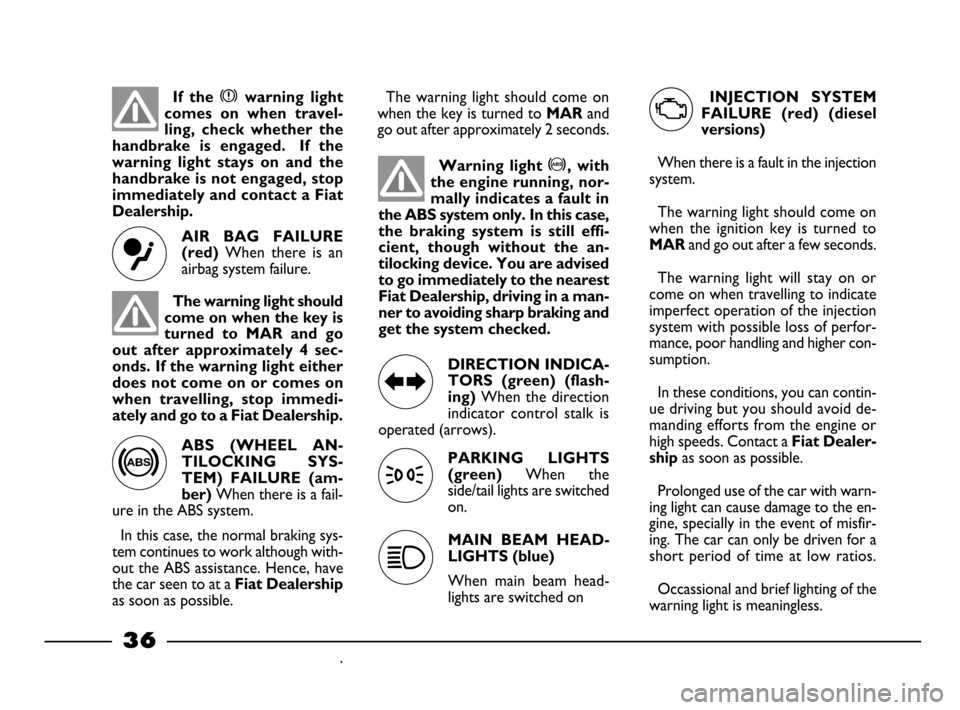
ABS (WHEEL AN-
TILOCKING SYS-
TEM) FAILURE (am-
ber)
When there is a fail-
ure in the ABS system.
In this case, the normal braking sys-
tem continues to work although with-
out the ABS assistance. Hence, have
the car seen to at a
Fiat Dealership
as soon as possible.
The warning light should come on
when the key is turned to
MARand
go out after approximately 2 seconds.
DIRECTION INDICA-
TORS (green) (flash-
ing)
When the direction
indicator control stalk is
operated (arrows).
PARKING LIGHTS
(green)
When the
side/tail lights are switched
on.
RE
3
MAIN BEAM HEAD-
LIGHTS (blue)
When main beam head-
lights are switched on
1
AIR BAG FAILURE
(red)
When there is an
airbag system failure.
If the xwarning light
comes on when travel-
ling, check whether the
handbrake is engaged. If the
warning light stays on and the
handbrake is not engaged, stop
immediately and contact a Fiat
Dealership.
>
Warning light >, with
the engine running, nor-
mally indicates a fault in
the ABS system only. In this case,
the braking system is still effi-
cient, though without the an-
tilocking device. You are advised
to go immediately to the nearest
Fiat Dealership, driving in a man-
ner to avoiding sharp braking and
get the system checked.
û
The warning light should
come on when the key is
turned to MAR and go
out after approximately 4 sec-
onds. If the warning light either
does not come on or comes on
when travelling, stop immedi-
ately and go to a Fiat Dealership.
The warning light should come on
when the key is turned to
MARand
go out after approximately 2 seconds.
36
INJECTION SYSTEM
FAILURE (red) (diesel
versions)
When there is a fault in the injection
system.
The warning light should come on
when the ignition key is turned to
MARand go out after a few seconds.
The warning light will stay on or
come on when travelling to indicate
imperfect operation of the injection
system with possible loss of perfor-
mance, poor handling and higher con-
sumption.
In these conditions, you can contin-
ue driving but you should avoid de-
manding efforts from the engine or
high speeds. Contact a
Fiat Dealer-
ship
as soon as possible.
Prolonged use of the car with warn-
ing light can cause damage to the en-
gine, specially in the event of misfir-
ing. The car can only be driven for a
short period of time at low ratios.
Occassional and brief lighting of the
warning light is meaningless.
20-63 03/03/2003 06:02 PM Page 36
Page 54 of 156

53
If you want to carry a
can of petrol as a reserve,
adhere to the laws in
force. Not following precautions
increases the risk of fire in the
event of an accident. To remove the
parcel shelf
1)
Free the upper extremities A-fig.
61
of the two tie rods, withdrawing
the eyelets from the pins.
2)Free the cover pins A-fig. 62
from their seats Band remove it.
After removing, the cover can be
transversally positioned between the
front seat backs and the tipped chush-
ion of the rear seat.
IMPORTANT If the load in the
boot is fairly heavy and you are trav-
elling at night, check and adjust the
height of the dipped beam headlights
(see“ Headlights” paragraph in this
chapter).
Heavy loads which are
not securely anchored
could seriously injure pas-
sengers in the event of an acci-
dent.
We suggest you do not
drive with the tailgate
open, as the exhaust gas-
es can come inside the car via the
boot.
fig. 62
P4E01750
20-63 03/03/2003 06:03 PM Page 53
Page 72 of 156
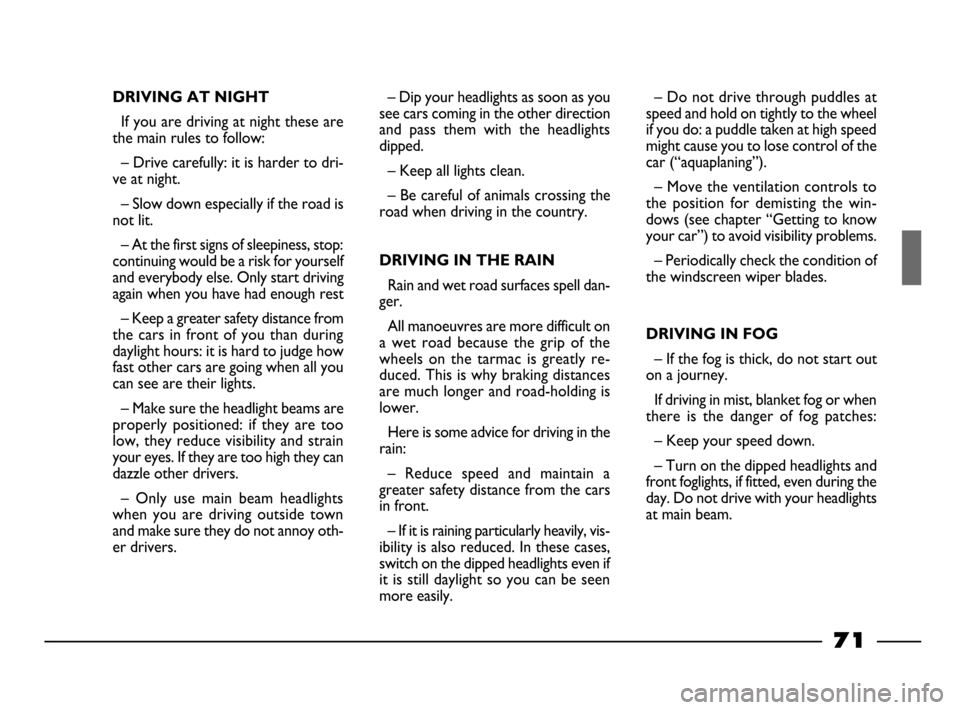
71
DRIVING AT NIGHT
If you are driving at night these are
the main rules to follow:
– Drive carefully: it is harder to dri-
ve at night.
– Slow down especially if the road is
not lit.
– At the first signs of sleepiness, stop:
continuing would be a risk for yourself
and everybody else. Only start driving
again when you have had enough rest
– Keep a greater safety distance from
the cars in front of you than during
daylight hours: it is hard to judge how
fast other cars are going when all you
can see are their lights.
– Make sure the headlight beams are
properly positioned: if they are too
low, they reduce visibility and strain
your eyes. If they are too high they can
dazzle other drivers.
– Only use main beam headlights
when you are driving outside town
and make sure they do not annoy oth-
er drivers.– Dip your headlights as soon as you
see cars coming in the other direction
and pass them with the headlights
dipped.
– Keep all lights clean.
– Be careful of animals crossing the
road when driving in the country.
DRIVING IN THE RAIN
Rain and wet road surfaces spell dan-
ger.
All manoeuvres are more difficult on
a wet road because the grip of the
wheels on the tarmac is greatly re-
duced. This is why braking distances
are much longer and road-holding is
lower.
Here is some advice for driving in the
rain:
– Reduce speed and maintain a
greater safety distance from the cars
in front.
– If it is raining particularly heavily, vis-
ibility is also reduced. In these cases,
switch on the dipped headlights even if
it is still daylight so you can be seen
more easily. – Do not drive through puddles at
speed and hold on tightly to the wheel
if you do: a puddle taken at high speed
might cause you to lose control of the
car (“aquaplaning”).
– Move the ventilation controls to
the position for demisting the win-
dows (see chapter “Getting to know
your car”) to avoid visibility problems.
– Periodically check the condition of
the windscreen wiper blades.
DRIVING IN FOG
– If the fog is thick, do not start out
on a journey.
If driving in mist, blanket fog or when
there is the danger of fog patches:
– Keep your speed down.
– Turn on the dipped headlights and
front foglights, if fitted, even during the
day. Do not drive with your headlights
at main beam.
64-79 03/03/2003 06:45 PM Page 71
Page 73 of 156
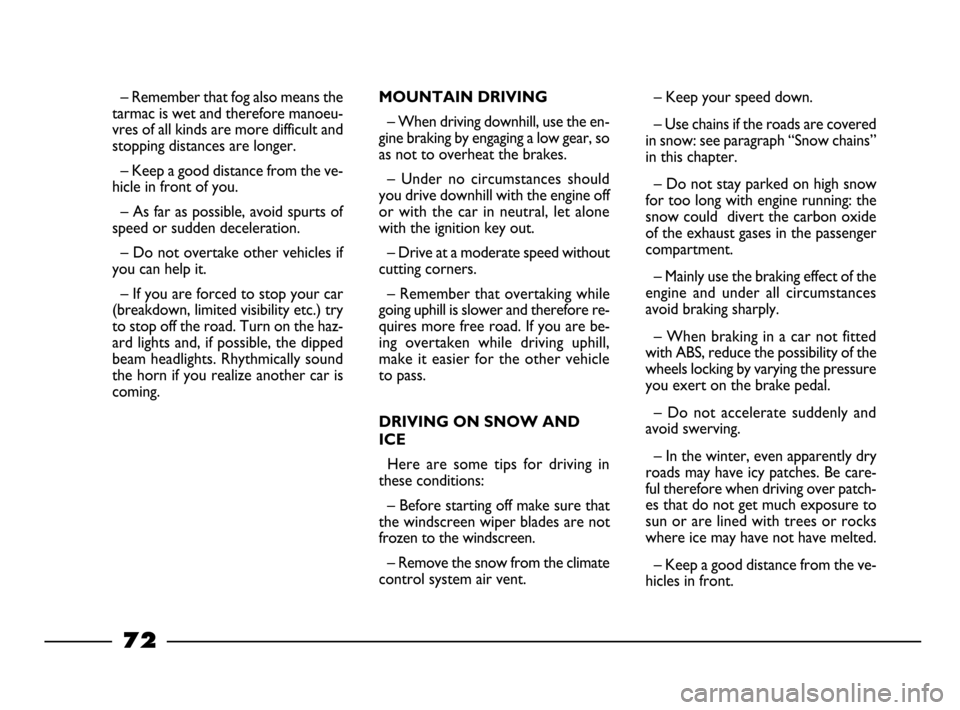
72
– Remember that fog also means the
tarmac is wet and therefore manoeu-
vres of all kinds are more difficult and
stopping distances are longer.
– Keep a good distance from the ve-
hicle in front of you.
– As far as possible, avoid spurts of
speed or sudden deceleration.
– Do not overtake other vehicles if
you can help it.
– If you are forced to stop your car
(breakdown, limited visibility etc.) try
to stop off the road. Turn on the haz-
ard lights and, if possible, the dipped
beam headlights. Rhythmically sound
the horn if you realize another car is
coming.MOUNTAIN DRIVING
– When driving downhill, use the en-
gine braking by engaging a low gear, so
as not to overheat the brakes.
– Under no circumstances should
you drive downhill with the engine off
or with the car in neutral, let alone
with the ignition key out.
– Drive at a moderate speed without
cutting corners.
– Remember that overtaking while
going uphill is slower and therefore re-
quires more free road. If you are be-
ing overtaken while driving uphill,
make it easier for the other vehicle
to pass.
DRIVING ON SNOW AND
ICE
Here are some tips for driving in
these conditions:
– Before starting off make sure that
the windscreen wiper blades are not
frozen to the windscreen.
– Remove the snow from the climate
control system air vent. – Keep your speed down.
– Use chains if the roads are covered
in snow: see paragraph “Snow chains”
in this chapter.
– Do not stay parked on high snow
for too long with engine running: the
snow could divert the carbon oxide
of the exhaust gases in the passenger
compartment.
– Mainly use the braking effect of the
engine and under all circumstances
avoid braking sharply.
– When braking in a car not fitted
with ABS, reduce the possibility of the
wheels locking by varying the pressure
you exert on the brake pedal.
– Do not accelerate suddenly and
avoid swerving.
– In the winter, even apparently dry
roads may have icy patches. Be care-
ful therefore when driving over patch-
es that do not get much exposure to
sun or are lined with trees or rocks
where ice may have not have melted.
– Keep a good distance from the ve-
hicles in front.
64-79 03/03/2003 06:45 PM Page 72
Page 87 of 156
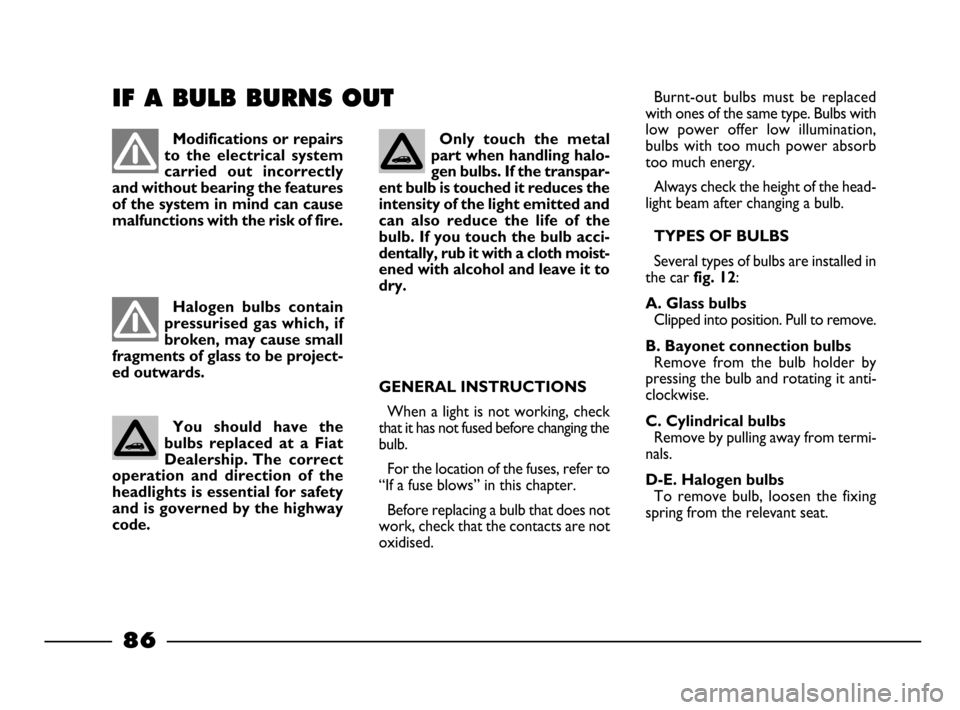
86
IF A BULB BURNS OUT
Modifications or repairs
to the electrical system
carried out incorrectly
and without bearing the features
of the system in mind can cause
malfunctions with the risk of fire.
You should have the
bulbs replaced at a Fiat
Dealership. The correct
operation and direction of the
headlights is essential for safety
and is governed by the highway
code.Only touch the metal
part when handling halo-
gen bulbs. If the transpar-
ent bulb is touched it reduces the
intensity of the light emitted and
can also reduce the life of the
bulb. If you touch the bulb acci-
dentally, rub it with a cloth moist-
ened with alcohol and leave it to
dry.
GENERAL INSTRUCTIONS
When a light is not working, check
that it has not fused before changing the
bulb.
For the location of the fuses, refer to
“If a fuse blows” in this chapter.
Before replacing a bulb that does not
work, check that the contacts are not
oxidised.
Halogen bulbs contain
pressurised gas which, if
broken, may cause small
fragments of glass to be project-
ed outwards.
Burnt-out bulbs must be replaced
with ones of the same type. Bulbs with
low power offer low illumination,
bulbs with too much power absorb
too much energy.
Always check the height of the head-
light beam after changing a bulb.
TYPES OF BULBS
Several types of bulbs are installed in
the car
fig. 12:
A. Glass bulbs
Clipped into position. Pull to remove.
B. Bayonet connection bulbs
Remove from the bulb holder by
pressing the bulb and rotating it anti-
clockwise.
C. Cylindrical bulbs
Remove by pulling away from termi-
nals.
D-E. Halogen bulbs
To remove bulb, loosen the fixing
spring from the relevant seat.
80-103 03/03/2003 06:49 PM Page 86
Page 148 of 156
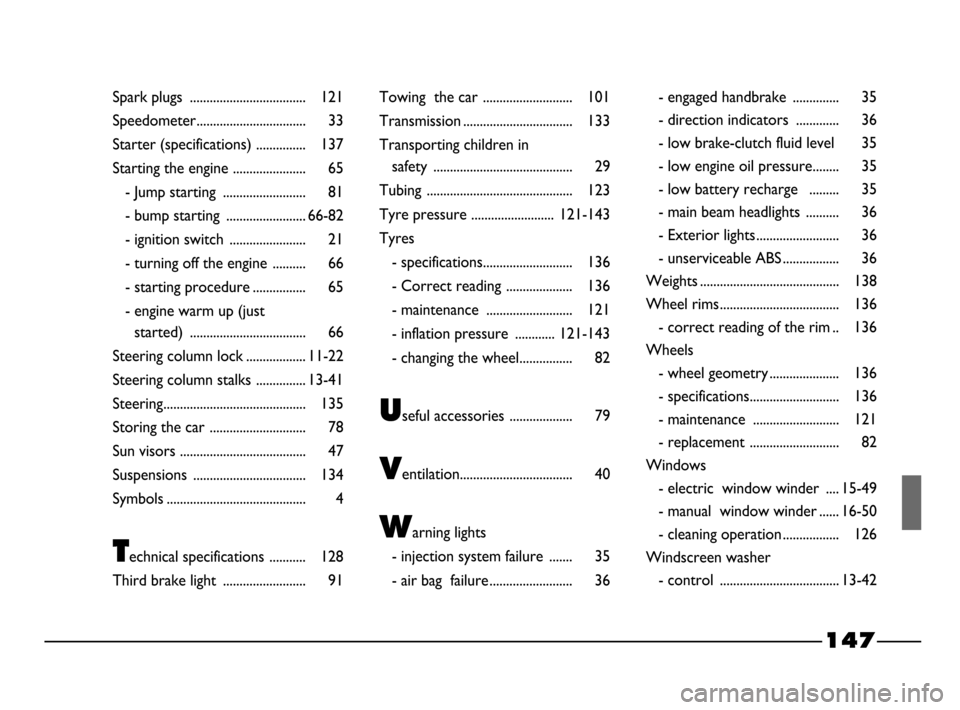
147
Spark plugs ................................... 121
Speedometer................................. 33
Starter (specifications) ............... 137
Starting the engine ...................... 65
- Jump starting ......................... 81
- bump starting ........................ 66-82
- ignition switch ....................... 21
- turning off the engine .......... 66
- starting procedure ................ 65
- engine warm up (just
started) ................................... 66
Steering column lock .................. 11-22
Steering column stalks ............... 13-41
Steering........................................... 135
Storing the car ............................. 78
Sun visors ...................................... 47
Suspensions .................................. 134
Symbols .......................................... 4
Technical specifications ........... 128
Third brake light ......................... 91Towing the car ........................... 101
Transmission ................................. 133
Transporting children in
safety .......................................... 29
Tubing ............................................ 123
Tyre pressure ......................... 121-143
Tyres
- specifications........................... 136
- Correct reading .................... 136
- maintenance .......................... 121
- inflation pressure ............ 121-143
- changing the wheel................ 82
Useful accessories ................... 79
Ventilation.................................. 40
Warning lights
- injection system failure ....... 35
- air bag failure ......................... 36- engaged handbrake .............. 35
- direction indicators ............. 36
- low brake-clutch fluid level 35
- low engine oil pressure........ 35
- low battery recharge ......... 35
- main beam headlights .......... 36
- Exterior lights ......................... 36
- unserviceable ABS ................. 36
Weights .......................................... 138
Wheel rims.................................... 136
- correct reading of the rim .. 136
Wheels
- wheel geometry ..................... 136
- specifications........................... 136
- maintenance .......................... 121
- replacement ........................... 82
Windows
- electric window winder .... 15-49
- manual window winder ...... 16-50
- cleaning operation ................. 126
Windscreen washer
- control .................................... 13-42
144-152 03/03/2003 07:30 PM Page 147